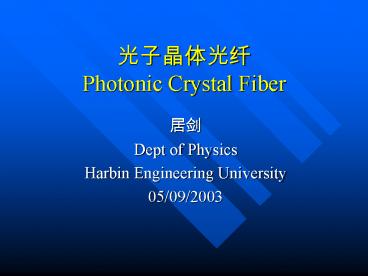?????? Photonic Crystal Fiber - PowerPoint PPT Presentation
1 / 28
Title:
?????? Photonic Crystal Fiber
Description:
Photonic Crystal Fiber Dept of Physics Harbin Engineering University 05/09/2003 Contents Principles of photonic crystal fiber (PCF ... – PowerPoint PPT presentation
Number of Views:1353
Avg rating:3.0/5.0
Title: ?????? Photonic Crystal Fiber
1
??????Photonic Crystal Fiber
- ??
- Dept of Physics
- Harbin Engineering University
- 05/09/2003
2
Contents
- Principles of photonic crystal fiber (PCF)
- Fabrication technology of PCF
- Categories of PCF and its application
- Highly birefringent PCF
- Splice loss estimation
- Conclusion
3
Principles of PCF
- Modified Total Internal Reflection (M-TIR)
- Photonic Band Gap (PBG)
4
M-TIR PCF
The refractive index of the microstructured
cladding exhibits a wavelength dependency very
different from pure silica which allows PCF to
display a complete new set properties.
5
PBG PCF
6
Photonic Band Gap PCF
- The periodic microstructure in PBG fibers results
in a so called photonic band gap, where light in
certain wavelength region cannot propagate. - In a PBG fiber, the core is created by
introducing a defect in the PBG structure (e.g.
an extra air hole), thereby creating an area
where the light can propagate.
7
Fabrication of PCF
- PCF preforms are formed by stacking a number of
capillary silica tubes and rods to form the
desired air/silica structure.
8
Fabrication of PCF
- High level of design flexibility
- Core size and shape
- Index profile
- Air hole arrangement
- This is very useful for fabrication of e.g.
polarization maintaining fibers with highly
asymmetric core regions, where multiple of the
capillary tubes is replaced with solid silica
rods.
9
Fabrication of PCF
- When the desired preform is constructed, it is
drawn to a fiber in a conventional
high-temperature drawing tower and hair-thin
photonic crystal fibers are readily produced in
kilometer lengths.
10
Fabrication of PCF
- Finally, the fibers are coated to provide a
protective standard jacket that allows robust
handling of the fibers. The final fibers are
comparable to standard fiber in both robustness
and size and can be both striped and cleaved
using standard tools.
11
Categories of PCF and its Applications
- Large mode area PCF
- High numerical aperture PCF
- Highly nonlinear PCF
- Air-guiding PCF
- Double cladding PCF
- Polarization maintaining PCF
12
Large Mode Area PCF
- Features
- Endlessly single-mode operation from UV to
infrared - Low nonliearities
- Core size 5µm20µm
- Applications
- High power delivery
- Laser pigtailing
13
High Numerical Aperture PCF
- High numerical aperture (NA)
- up to 0.7
- Large core area
- Low nonliearities
14
Highly nonlinear PCF
- Features
- Very small core size (down to 1 µm)
- zero dispersion from 600 to 1550 nm
- Bending insensitive
- Applications
- Supercontinuum generation
- Optical coherence tomopraphy
- Raman amplification
- Optical parametric amplification
15
Chromatic Dispersion
16
Supercontinuum Generation
- Super continuum generation in a 75cm length of
PCF. The fiber is pumped with 100fs, 680nm pulse.
The pulse energy is 1nJ.
17
Air-guiding PCF
- Low bend loss unnoticeable _at_ 3mm radius
- Low Fresnel reflection lt10-4
- Reduced nonlinearities
- Potential ultra-low loss transmission
18
Double Cladding PCF
- Extremely high NA for the pump core/inner
cladding. - Large mode area for signal mode signal high
power delivery, low nonlinearity, and a good
overlap between pumping and signal area (high
pump efficiency)
19
Polarization Maintaining PCF
- Higher birefringence (shorter beatlength)
- Improved extinction ratio gt30dB over 100m
- Low loss lt1dB/km _at_ 1550nm
- Low temperature coefficient of birefringence
- 30 times lower than that of Panda fiber
20
My Work
- Modeling of a highly birefringent PCF
- Splice loss estimation of PCF/SMF
21
Modeling of Highly Birefringent PCF
The cross-section of the PCF and electric field
vectors of the y-polarized fundamental mode.
Dependence of modal birefringence on the size
of holes.
22
- The mode field diameter and half divergence
angle as a function of wavelength for various
d2/?. The dashed and solid lines corresponds to x
and y directions respectively.
23
- Cutoff considerations For d10.4µm and d2/?0.8,
single mode operation 1.4µm d2/?0.5,
single-mode at wavelength 1.3µm. - The group velocity dispersion (GVD)
x-polarized solid line y-polarized doted
line .
24
Splice Loss Estimation of PCF/SMF
25
MFD as function of pitch for different d/?
- The above formula is accurate to within 1 .
26
- Splice loss as a function of pitch ? for various
d/?. Dash-dot line results computed using above
equations Solid line Results obtained from
overlap integral of vector field distributions.
(Error lt0.2dB)
27
Conclusions
- Working principles
- Fabrication technology
- Various structures
- Applications
- Personal work
28
- Questions and Answers
- Thank You !































